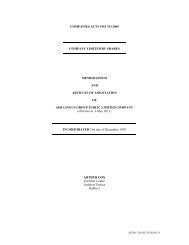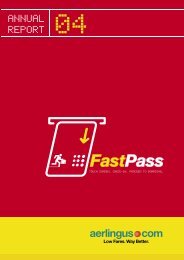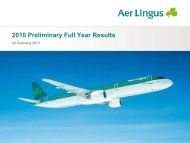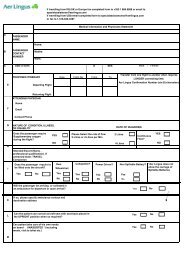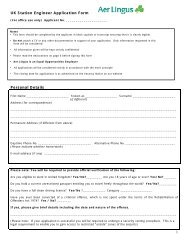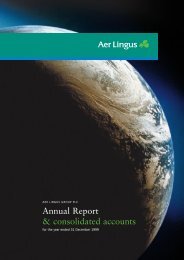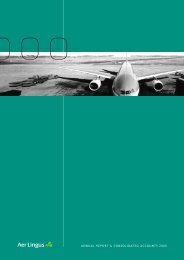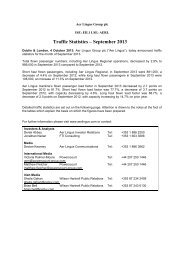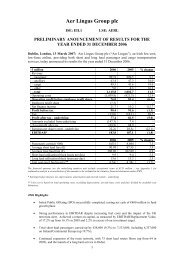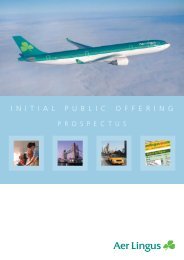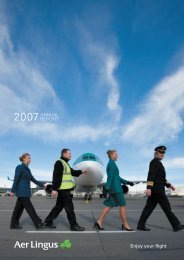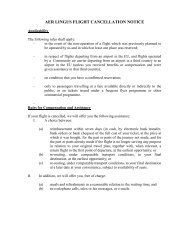annual report 2009 - Aer Lingus
annual report 2009 - Aer Lingus
annual report 2009 - Aer Lingus
Create successful ePaper yourself
Turn your PDF publications into a flip-book with our unique Google optimized e-Paper software.
68 Financial Statements <strong>Aer</strong> <strong>Lingus</strong> Group Plc – Annual Report <strong>2009</strong>Notes to the Consolidated Financial Statements [continued]4 Critical accounting estimates and judgementsThe Group believes that of its significant accounting policies and estimates, the following may involve a higher degree of judgementand complexity:(a) ProvisionsThe Group makes provisions for legal and constructive obligations, which it knows to be outstanding at the <strong>report</strong>ing date. Theseprovisions are generally made based on historical or other pertinent information, adjusted for recent trends where relevant. However,they are estimates of the financial costs of events that may not occur for some years. The actual outturn may differ significantly fromthat estimated.(b) Post retirement benefitsAs the provisions of trust deeds governing the Irish Pension Schemes are such that no changes to the contribution rates are possiblewithout the prior consent of the Group, the Group has concluded that it has no obligation, legal or constructive, to increase itscontributions beyond those levels. As such, it has accounted for the Irish Pension Schemes as defined contribution schemes underthe provisions of IAS 19 Employee Benefits, and, as a result, does not recognise any surplus or deficit in the schemes on the statementof financial position.If any legal or constructive obligation to vary the Group’s contributions based on the funding status of the Irish Pension Schemes arises,IAS 19 requires the Group to include any pension fund surplus or deficit on its statement of financial position and reflect any period onperiod movements in its income statement or the statement of comprehensive income.(c) ImpairmentThe Group tests, in accordance with the accounting policy stated in Note 2.7, whether property, plant and equipment has suffered anyimpairment when, at the end of a <strong>report</strong>ing period, there is any indication that an asset may be impaired. The recoverable amountsare determined based on value-in-use calculations. These calculations require the use of estimates and are sensitive to the growthrate assumed for the Group and the discount rate used to estimate the present value of future cash flows.5 Segment informationIFRS 8 Operating Segments requires us to disclose certain information about our operating segments. An operating segment is definedas a component of an entity that engages in business activities from which it earns revenues and incurs expenses, with discrete financialinformation, which is evaluated regularly by the chief operating decision maker and used in resource allocation and to assessperformance.The Group is managed as a single business unit that provides air transportation for passengers and cargo, which allows the Group tobenefit from an integrated revenue pricing and route network. Our flight equipment forms one fleet, which is deployed through a singleroute scheduling system. When making resource allocation decisions, the chief operating decision maker evaluates flight profitabilitydata, which considers aircraft type and route economics. Based on the way the Group treats the network and the manner in whichresource allocation decisions are made the Group considers each route to be an operating segment, however having assessed theaggregation criteria specified in IFRS 8, the Group has determined that it has only one operating segment for financial <strong>report</strong>ingpurposes. In prior years, segment information <strong>report</strong>ed externally was analysed on the basis of the types of service supplied by theGroup, i.e. passenger travel and cargo transportation, however information <strong>report</strong>ed to the executive management team is morespecifically focused on flight profitability data.The chief operating decision maker assesses the performance of the operating segment based on a measure of adjusted operatingprofit before net exceptional items, interest and tax. This measure excludes the effects of non-recurring expenditure and revenuefrom the operating segment, such as restructuring costs and provision remeasurements, when the remeasurements are the resultof an isolated, non-recurring event. These are aggregated in the ‘miscellaneous group level adjustments’ caption below. Interestincome and expenditure are not included in the result of the operating segment that is reviewed by the chief operating decision maker.



